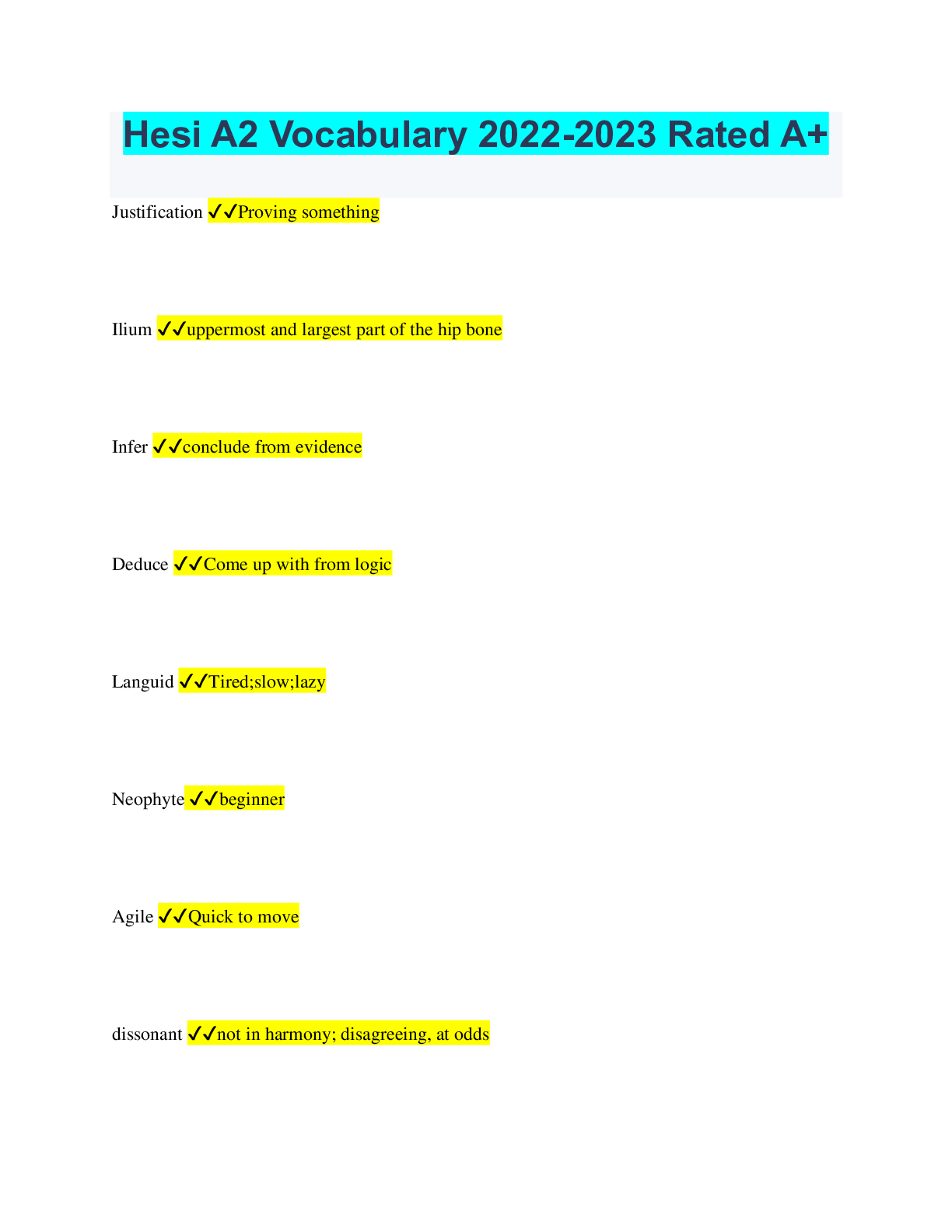
Hesi A2 Vocabulary 2022-2023 Rated A+
$ 10

eBook Hybridity in Life Writing Combining Text and Images 1st Edition By Arnaud Schmitt
Pharmacology > TEST BANKS > TEST BANK FOR Pharmacology for Nurses A Pathophysiologic Approach, 7th Edition by Michael P. Adams N (All)
TEST BANK FOR Pharmacology for Nurses A Pathophysiologic Approach, 7th Edition by Michael P. Adams Norman Holland Shanti Chang-The nurse is reviewing key events in the history of pharmacology with a s ... tudent nurse. Which student comment indicates an understanding? "Early researchers used themselves as test subjects." "A primary goal of pharmacology is to prevent disease." "Penicillin is one of the initial drugs isolated from a natural source." "Pharmacologists began synthesizing drugs in the laboratory in the nineteenth century." Answer: 1 Explanation: Some early researchers, like Friedrich Serturner, used themselves as test subjects. An early goal of pharmacology was to relieve human suffering. Initial drugs isolated from complex mixtures included morphine, colchicine, curare, and cocaine, but not penicillin. By the twentieth century, pharmacologists could synthesize drugs in the laboratory. Page Ref: 3 Cognitive Level: Analyzing Client Need/Sub: Physiological Integrity: Pharmacological and Parenteral Therapies Standards: QSEN Competencies: I.A.1 Integrate understanding of multiple dimensions of patient-centered care: patient/family/community preferences, values; coordination and integration of care; information, communication, and education; physical comfort and emotional support; involvement of family and friends; and transition and continuity. | AACN Domains and Competencies: 1.1 Demonstrate an understanding of the discipline of nursing's distinct perspective and where shared perspectives exist with other disciplines. | NLN Competencies: Knowledge and Science: Integration of knowledge from nursing and other disciplines. | Nursing/Integrated Concepts: Nursing Process: Evaluation Learning Outcome: 1-1 Identify key events in the history of pharmacology. MNL Learning Outcome: Examine the relationship between medicine and pharmacology. The nursing student asks why anatomy and physiology as well as microbiology are required courses when learning about pharmacology. Which response will the instructor make? "Because pharmacology is an outgrowth of those subjects." "You must learn all, since all of those subjects are part of the curriculum." "Knowledge of all those subjects will prepare you to administer medication." "An understanding of those subjects is essential to understand pharmacology." Answer: 4 Explanation: Pharmacology is an outgrowth of anatomy, physiology, and microbiology, but this is not the most essential reason for the nurse to learn them. The nurse must learn anatomy, physiology, and microbiology to understand pharmacology, not because they are part of the curriculum. Knowledge of anatomy, physiology, and microbiology prepares the nurse to understand pharmacology, not to provide care such as administration of medications. It is essential for the nurse to have a broad knowledge base of many sciences in order to learn pharmacology. Page Ref: 4 Cognitive Level: Applying Client Need/Sub: Physiological Integrity: Pharmacological and Parenteral Therapies Standards: QSEN Competencies: I.A.1 Integrate understanding of multiple dimensions of patient-centered care: patient/family/community preferences, values; coordination and integration of care; information, communication, and education; physical comfort and emotional support; involvement of family and friends; and transition and continuity. | AACN Domains and Competencies: 1.1 Demonstrate an understanding of the discipline of nursing's distinct perspective and where shared perspectives exist with other disciplines. | NLN Competencies: Knowledge and Science: Integration of knowledge from nursing and other disciplines. | Nursing/Integrated Concepts: Nursing Process: Implementation Learning Outcome: 1-2 Explain the interdisciplinary nature of pharmacology, giving an example of how knowledge from different sciences impacts the nurse's role in drug administration. MNL Learning Outcome: Identify how drugs are named and classified. The nurse is teaching about the differences between pharmacology and therapeutics. Which statement indicates that teaching was effective? Note: Credit will be given only if all correct choices and no incorrect choices are selected. Select all that apply. "Pharmacology is the development of medicines." "Pharmacology is the study of medicines." "Therapeutics relates to drug use to treat suffering." "Therapeutics is the study of drug interactions." "Pharmacology is the study of drugs to prevent disease and alleviate suffering." Answer: 2, 3, 5 Explanation: Pharmacology is not the development of medicines. Pharmacology is the study of medicines. Therapeutics is the use of drugs in the treatment of suffering. Therapeutics is not related to the study of drug interactions. Pharmacology is the study of drugs for the purpose of disease prevention and to alleviate suffering. Page Ref: 4 Cognitive Level: Analyzing Client Need/Sub: Physiological Integrity: Pharmacological and Parenteral Therapies Standards: QSEN Competencies: I.A.1 Integrate understanding of multiple dimensions of patient-centered care: patient/family/community preferences, values; coordination and integration of care; information, communication, and education; physical comfort and emotional support; involvement of family and friends; and transition and continuity. | AACN Domains and Competencies: 1.1 Demonstrate an understanding of the discipline of nursing's distinct perspective and where shared perspectives exist with other disciplines. | NLN Competencies: Knowledge and Science: Integration of knowledge from nursing and other disciplines. | Nursing/Integrated Concepts: Nursing Process: Evaluation Learning Outcome: 1-3 Compare and contrast therapeutics and pharmacology. MNL Learning Outcome: Identify how drugs are named and classified. The nurse is preparing to administer a vaccine to a client. Which information about the manufacture of vaccines should the nurse recall when administering this medication? The vaccine is produced by natural plant extracts in the laboratory. The vaccine is naturally produced in animal cells or microorganisms. The vaccine is produced by a combination of animal and plant products. The vaccine is most commonly synthesized in a laboratory. Answer: 2 Explanation: Vaccines are not produced by natural plant extracts. Vaccines are naturally produced in animal cells, microorganisms, or by the body itself. Vaccines are not produced by a combination of animal and plant products. Vaccines are not synthesized in a laboratory. Page Ref: 4 Cognitive Level: Applying Client Need/Sub: Physiological Integrity: Pharmacological and Parenteral Therapies Standards: QSEN Competencies: III.A.1 Demonstrate knowledge of basic scientific methods and processes. | AACN Domains and Competencies: 5.2 Contribute to a culture of patient safety. | NLN Competencies: Knowledge and Science: Integration of knowledge from nursing and other disciplines. | Nursing/Integrated Concepts: Nursing Process: Evaluation Learning Outcome: 1-4 Compare and contrast traditional drugs, biologics including biosimilars, and complementary and alternative medicine therapies. MNL Learning Outcome: Identify how drugs are named and classified. An older client with gastrointestinal bleeding asks why the condition developed when only ibuprofen was used to self-treat arthritis. Which response should the nurse make? "There are nonpharmacologic methods to relieve joint pain." "Maybe you should take acetaminophen because it is safer." "Ask your healthcare provider before taking over-the-counter medications." "I'm going to review the side effects of ibuprofen with you." Answer: 4 Explanation: Reviewing nonpharmacologic methods to relieve joint pain is appropriate for this client, but it's not the highest priority. It doesn't address the client's current concern about how ibuprofen may have increased the risk of having a GI bleed. Substitution of other drugs may be beneficial; however, it is beyond the nurse's scope of practice to suggest or prescribe medications. It is not a realistic plan to expect clients to contact the healthcare provider prior to taking any over-the-counter medication. In addition, it doesn't address the client's current concern about how ibuprofen may have increased the risk of having a GI bleed. It is essential for the nurse to teach clients about the advantages, and the disadvantages (including side effects), of all medications and supplements the client is taking. Page Ref: 6 Cognitive Level: Applying Client Need/Sub: Physiological Integrity: Pharmacological and Parenteral Therapies Standards: QSEN Competencies: III.A.1 Demonstrate knowledge of basic scientific methods and processes. | AACN Domains and Competencies: 2.2 Communicate effectively with individuals. | NLN Competencies: Context and Environment: Health promotion/disease prevention. | Nursing/Integrated Concepts: Nursing Process: Implementation Learning Outcome: 1-9 Outline the major differences between prescription and over-the-counter drugs. MNL Learning Outcome: Identify how drugs are named and classified. The nurse discusses with a new graduate the pharmacological classification of drugs. Which response indicates that teaching provided to the new graduate was effective? "An anti-anginal treats angina." "A calcium channel blocker blocks heart calcium channels." "An antihypertensive lowers blood pressure." "An anticoagulant influences blood clotting." Answer: 2 Explanation: Saying that a drug treats angina addresses the therapeutic usefulness of the drug, not the pharmacological classification. The pharmacological classification addresses a drug's mechanism of action, or how a drug produces its effect in the body. Stating that a drug lowers blood pressure addresses the therapeutic usefulness of the drug, not the pharmacological classification. Explaining that a drug influences blood clotting addresses the therapeutic usefulness of the drug, not the pharmacological classification. Page Ref: 5 Cognitive Level: Analyzing Client Need/Sub: Physiological Integrity: Pharmacological and Parenteral Therapies Standards: QSEN Competencies: III.A.1 Demonstrate knowledge of basic scientific methods and processes. | AACN Domains and Competencies: 2.2 Communicate effectively with individuals. | NLN Competencies: Knowledge and Science: Integration of knowledge from nursing and other disciplines. | Nursing/Integrated Concepts: Nursing Process: Evaluation Learning Outcome: 1-5 Explain the basis for placing drugs into therapeutic and pharmacologic classes. MNL Learning Outcome: Examine the basic concepts of pharmacology. A nurse is providing medication education to a client with hypertension. The nurse teaches the client that the healthcare provider ordered a diuretic to decrease the amount of fluid in the client's body. Which statement best describes the nurse's instruction? The nurse provided appropriate medication education. The nurse explained the drug's mechanism of action. The nurse taught the client about a prototype drug. The nurse explained the consequences of not using the drug. Answer: 2 Explanation: The education was most likely appropriate, but this response is too vague. A drug's mechanism of action explains how a drug produces its effect in the body. There is no drug name present, so it is not known whether this is a prototype drug. The nurse did not explain the consequences of not using the drug. Page Ref: 5 processes. | AACN Domains and Competencies: I.7 Integrate the knowledge and methods of a variety of disciplines to inform decision making. | NLN Competencies: Knowledge and Science: Integration of knowledge from nursing and other disciplines. | Nursing/Integrated Concepts: Nursing Process: Evaluation Learning Outcome: 1-7 Describe what is meant by a drug's mechanism of action. MNL Learning Outcome: Examine the basic concepts of pharmacology. [Show More]
Last updated: 8 months ago
Preview 5 out of 1311 pages

Loading document previews ...
Buy this document to get the full access instantly
Instant Download Access after purchase
Buy NowInstant download
We Accept:

Can't find what you want? Try our AI powered Search
Connected school, study & course
About the document
Uploaded On
Oct 09, 2024
Number of pages
1311
Written in
All
This document has been written for:
Uploaded
Oct 09, 2024
Downloads
0
Views
85
Scholarfriends.com Online Platform by Browsegrades Inc. 651N South Broad St, Middletown DE. United States.
We're available through e-mail, Twitter, Facebook, and live chat.
FAQ
Questions? Leave a message!
Copyright © Scholarfriends · High quality services·